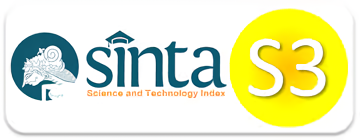ANALYZING THE STRATEGIC ALIGNMENT BETWEEN INFORMATION SYSTEM TECHNOLOGY AND BUSINESS PROCESS IN SMALL MEDIUM ENTERPRISE (SME) USING FRAMEWORK COBIT 4.1– A CASE STUDY IN UNIVERSAL TRADING, SURABAYA
Downloads
This research was conducted in Universal Trading as one of SME that applies Information Technology as daily business process in order to analyze whether the use of Information Technology is alligned with the strategy formulation. Type of research is Descriptive Research with Qualitative technique by using direct observation and depth interview with all user of TI from leader to staff. In depicting a further detail description, Internal and External Matrixas well as COBIT Verse 4.1 were utilized in supporting so. From the position of Average as a result of IFE-EFE Matrix and the Score of COBIT 4.1 in primary process of Strategic Allingment is 2,95 could be concluded that only strategy of new market penetration could be alligned by the use of Information Technology as the company basic business process is limiting the strategy of new product development using only company's internal source.
Keyword: strategic allignment, information technology, COBIT 4.1
Cooper, D. R. & Schindler, P. S., 2008. Business Research Method. 10 ed. New York: McGraw-Hill.
David, F. R., 2011. Strategic Management : Concept & Cases. 13th ed. New Jersey: Prentice Hall.
Djohan, M., 2011. Indonesia's Economy to Survive Global Economic Crisis. [Online] Available at: http://news.xinhuanet.com/english/business/2011-12/15/c/
htm
Fakhrana, R. S., 2016. Riset: UKM Indonesia Belum Sadar Teknologi. [Online]
Available at: http://www.cnnindonesia.com/teknologi/20160728154426-185-147674/riset-ukm-indonesia-belum-sadar-teknologi/ [Accessed 1 April 2017].
Gondodiyoto, S., 2007. Audit Sistem Informasi - Pendekatan COBIT. 1st ed. Jakarta: Mitra Wacana Media.
IT Governance Istitute, 2007. COBIT 4.1 Excerpt. [Online] Available at: https://www.isaca.org/Knowledge-Center/cobit/Documents/COBIT4.pdf [Accessed 2nd April 2017].
Jurevicius, O., 2014. IFE & EFE Matrices. [Online] Available at: https://www.strategicmanagementinsight.com/tools/ife-efe-matrix.html [Accessed 3 April 2017].
Khusnir, K., Mlimulstein, Melina, L. & Ramalho, R., 2010. Micro, Small and Medium Enterprise Around the World : How Many Are They and What the Effect of World Economy. Micro, Small and Medium Enterprise, The International Finance Corporation, World Bank Group, 3(1), pp. 1-8.
Rahman, H., 2006. SMEs In Indonesian Economy and Policies to Enhance Development and Empowerement of Indonesia. Haikou City, International Comparison on Private Sector Development Strategy.
Raz, A., 2012. The Euro Crisis and Its Impact on Indonesia's Economy. [Online]
Available at: http://www.thejakartapost.com/news/2012/06/07/the-euro-crisis-and-its-impact-indonesia-s-economy.html
Raz, A. F., 2012. The euro crisis and its impact on Indonesia's economy. [Online]
Available at: http://www.thejakartapost.com/news/2012/06/07/the-euro-crisis-and-its-impact-indonesia-s-economy.html [Accessed 26 February 2013].
Ritchie, J. & Lewis, J., 2003. Qualitative Research Practice: A Guide for Social Science Students and Researchers. 1st ed. London: SAGE Publication.
Sarno, 2009. Audit Sistem & Teknologi Informasi. 1st ed. Surabaya: ITS Press.
Scwhab, K. & Brende, B., 2012. The Global Competitiveness Report 2012-2013, Geneva: World Economic Forum.
Tambunan, T., 2011. Trade Liberalization Effects on The Development of Small and Medium-Sized Enterprise in Indonesia. A Case Study of Asia-Pasific Development Journal, 13(2), pp. 35-59.
Copyright notice:
- Authors retain copyright and grant the journal right of first publication with the work simultaneously licensed under a Creative Commons Attribution-NonCommercial-ShareAlike 4.0 International License that allows others to share the work with an acknowledgement of the work's authorship and initial publication in this journal.
- Authors are able to enter into separate, additional contractual arrangements for the non-exclusive distribution of the journal's published version of the work with an acknowledgement of its initial publication in this journal.
- Authors are permitted and encouraged to post their work online (e.g., in institutional repositories or on their website) prior to and during the submission process, as it can lead to productive exchanges, as well as earlier and greater citation of published work (See The Effect of Open Access)
















